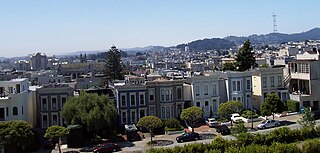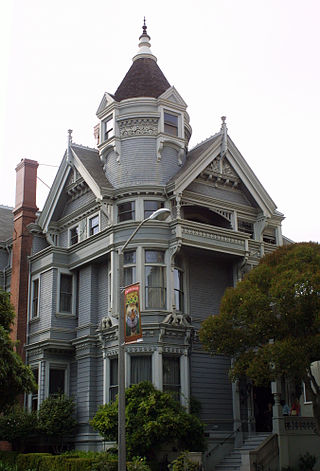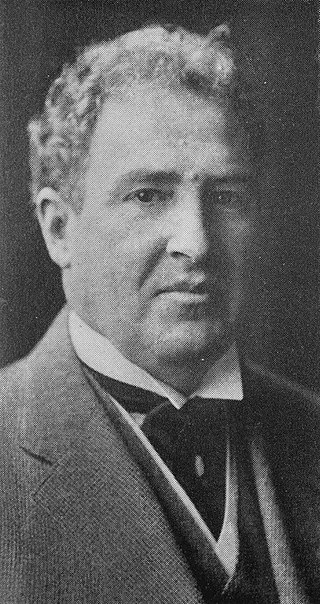
Bernard Ralph Maybeck was an American architect in the Arts and Crafts Movement of the early 20th century. He worked primarily in the San Francisco Bay Area, designing public buildings, including the Palace of Fine Arts in San Francisco, and also private houses, especially in Berkeley, where he lived and taught at the University of California. A number of his works are listed on the National Register of Historic Places.

The Western Addition is a district in San Francisco, California, United States.

The Haas–Lilienthal House is a historic building located at 2007 Franklin Street in San Francisco, California, United States, within the Pacific Heights neighborhood. Built in 1886 for William and Bertha Haas, it survived the 1906 San Francisco earthquake and subsequent fire. The Victorian era house is a San Francisco Designated Landmark and is listed on the U.S. National Register of Historic Places. It was converted into a museum with period furniture and artifacts, which as of 2016 received over 6,500 visitors annually.

The James C. Flood Mansion is a historic mansion at 1000 California Street, atop Nob Hill in San Francisco, California, USA. Now home of the Pacific-Union Club, it was built in 1886 as the townhouse for James C. Flood, a 19th-century silver baron. It was the first brownstone building west of the Mississippi River, and the only mansion on Nob Hill to structurally survive the 1906 San Francisco earthquake and fire. It was declared a National Historic Landmark in 1966.

The James R. Browning U.S. Court of Appeals Building is a historic post office and courthouse building located at San Francisco, California. It is a courthouse for the United States Court of Appeals for the Ninth Circuit. Completed in 1905 as the U.S. Courthouse and Post Office, it was intended to represent the affluence and increasing importance of the United States as it became a world power. The building survived both the 1906 San Francisco earthquake and the 1989 Loma Prieta earthquake.

John Virginius Bennes was an American architect who designed numerous buildings throughout the state of Oregon, particularly in Baker City and Portland. In Baker City he did an extensive redesign of the Geiser Grand Hotel, designed several homes, and a now-demolished Elks building. He moved to Portland in 1907 and continued practicing there until 1942.

The Bank of California Building is a 1908 Greco-Roman style structure with a brutalist, 312 ft (95 m), 22-story tower annexed in 1967 at 400 California Street in the financial district of San Francisco, California.

John Buck Leonard (1864–1945) was a pioneering bridge engineer and architect, early advocate for reinforced concrete, working mainly in northern California.

Henry William Cleaveland was an American architect based in New York, New York, and then San Francisco, California, and Portland, Oregon. He was one of the founding members of the American Institute of Architects, and several of his works have been listed on the National Register of Historic Places. His works include Ralston Hall, a National Historic Landmark in the San Francisco Bay Area, the original Palace Hotel in San Francisco, and the Bidwell Mansion in Chico, California.

St. Joseph's Church and Complex is a historic church built in 1906, and located at 1401–1415 Howard Street in the South of Market neighborhood of San Francisco, California, United States.

The Bank of Lucas, Turner & Company, also known as Sherman's Bank, is a historic building that was formerly a bank building, located at 800–804 Montgomery Street in Jackson Square in San Francisco, California.
Walter Danforth Bliss (1874-1956) was an American architect from California. Many of his buildings are listed on the National Register of Historic Places.

The Ritz-Carlton Club and Residences is a 312-foot (95 m) luxury residential skyscraper in the Financial District of San Francisco, California. The residences are built atop the historic Old Chronicle Building, sometimes called the de Young Building, which was constructed in 1890. It is the first skyscraper built in California.
Frederick Herman Meyer was an American architect. He was active in the San Francisco Bay Area, and is known for designing the YMCA Hotel in San Francisco. From c.1898 until 1901, Samuel Newsom worked with Meyer, to form the firm Newsom and Meyer in Oakland. Starting in 1902 and until 1908, Meyer entered into a partnership with architect Smith O'Brien to form the form Meyer and O'Brien.
William Baker Faville (1866–1946) was an American architect.
Percy & Hamilton was an architectural firm in San Francisco, California during 1880 to 1899.

Archbishop's Mansion is a historic house built in 1904 and located at 1000 Fulton Street in the Alamo Square neighborhood in San Francisco, California. The mansion was built for Patrick William Riordan, the second Roman Catholic Archbishop of San Francisco.

The Colombo Building, also known as the Drexler Building or Drexler-Colombo Building, is a historic commercial building built in 1913, and is located at 1–21 Columbus Avenue in the Jackson Square Historic District in San Francisco, California.

The Atkinson House is a historic house built in 1853, and located in the Russian Hill area of San Francisco, California. It is one of the oldest residences in the city still standing, and possibly one of the first Italianate-style homes in the city. It is also known as the Katherine Atkinson House, and Atkinson-Escher House.

Golden Sheaf Bakery is a historical building and former bakery built in 1905 and located at 2069–2071 Addison Street in Berkeley, California, U.S. It is listed on the National Register of Historic Places since March 31, 1978; listed as a California Historical Landmark since March 31, 1978; and listed as a Berkeley Landmark since October 17, 1977.




















